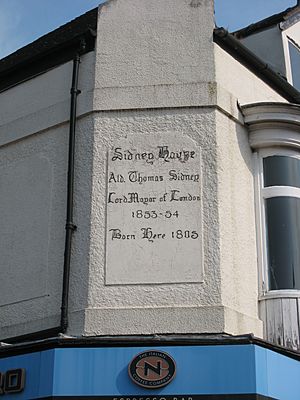Thomas Sidney facts for kids
Quick facts for kids
Thomas Sidney
|
|
|---|---|
| Member of Parliament for Stafford |
|
| In office 3 August 1860 – 11 July 1865 Serving with Thomas Salt
|
|
| Preceded by | John Ayshford Wise Thomas Salt |
| Succeeded by | Michael Bass Walter Meller |
| In office 30 July 1847 – 8 July 1852 Serving with David Urquhart
|
|
| Preceded by | Swynfen Carnegie Edward Manningham-Buller |
| Succeeded by | John Ayshford Wise Arthur Otway |
| Lord Mayor of London | |
| In office 1853–1854 |
|
| Preceded by | Thomas Challis |
| Succeeded by | Francis Moon |
| Personal details | |
| Born | 5 January 1805 Stafford, Staffordshire |
| Died | 10 March 1889 (aged 84) St Leonards-on-Sea, East Sussex |
| Resting place | St Michael-at-Bowes, Bowes Park, Middlesex |
| Nationality | British |
| Political party | Liberal |
| Other political affiliations |
Conservative |
| Spouses |
Eleanor Mary Ward
(m. 1860)Sarah Hall
(m. 1831; died 1857) |
| Residences | Bowes Manor, Middlesex |
Thomas Sidney (born January 5, 1805, died March 10, 1889) was an important British politician and a successful tea merchant. He was a member of both the Liberal Party and the Conservative Party during his career.
Contents
Early Life and Family
Thomas Sidney was born in Stafford in 1805. His parents were William and Ann Sidney. He went to Stafford Grammar School. Later, he became a tea importer and merchant in London in 1838.
Thomas Sidney married Sarah Hall in 1831. They had one daughter named Ellen. After Sarah passed away in 1857, he married Eleanor Mary Ward in 1860. He also had another child named Thomas Stafford.
Political Career
Thomas Sidney had a long career in politics. He started as a City Councillor for the City of London from 1843 to 1844. After that, he became an alderman for Billingsgate in 1844. He held this important position for 36 years.
He also served as Sheriff of the City of London and Middlesex in 1844. From 1853 to 1854, he was the Lord Mayor of London. Interestingly, the next Lord Mayor, Francis Moon, was the father of his son-in-law, Edward Graham Moon.
Member of Parliament
Sidney was first chosen as a Conservative MP for Stafford in 1847. He decided not to run again in 1852. He tried to become an MP for Leeds but was not successful.
He tried again in 1857 for Worcester as a Conservative, but he did not win. In 1859, he returned to Stafford and ran as a Liberal.
He became an MP again for Stafford in 1860 after a special election. He stayed in this role until 1865, when he decided to retire from Parliament.
Bowes Manor Estate
In 1855, Thomas Sidney started leasing a large property called Bowes Manor in Bowes Park. He later bought the property in 1866. He began to develop the land around 1870. He created a road called Palmerston Road and built 30 large houses near the New River.
Sidney also helped pay for the building of St Michael-at-Bowes Church. This church was finished in 1874. He is buried there today.
After he passed away in 1889, Bowes Manor and its land were put up for sale. However, no one bought it. Instead, it was leased out and later sold for new buildings in 1899.
Other Activities
Besides his political roles, Thomas Sidney was also a Justice of the Peace for Middlesex and Westminster. This meant he helped keep law and order. He was also a Deputy Lieutenant for London.
In 1849, he was an Overseer of the Poor, helping people in need. He also served as a churchwarden for his local church in 1852 and 1853.


